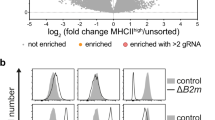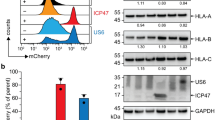Abstract
ANTIGEN processing provides major histocompatibility complex (MHC) class I molecules with short peptides, which they selectively bind and present to cytotoxic T lymphocytes1–4. The proteolytic system generating these peptides in the cytosol is unidentified, but their delivery into the endoplasmic reticulum is mediated by the TAP1–TAP2 transporter encoded in the MHC class II region5–9. Closely linked to TAP1 and TAP2 are genes for the LMP2 and LMP7 proteins10, which resemble components of proteasomes11–13, proteolytic complexes known to degrade cytosolic proteins14. This association has led to the common assumption that proteasomes function in this immunological pathway (discussed in ref. 15). We now show that the expression of stably assembled class I molecules and apparently normal peptide processing can be completely restored in the absence of LMP2 and LMP7 in the human lymphoblastoid cell line mutant 721.174 (refs 16, 17). The identity of LMP7 is directly confirmed by reconstitution of a proteasomal subunit after gene transfer. These results therefore dispute the hypothetical involvement of proteasomes in antigen processing, although a more subtle effect of LMP2 and LMP7 cannot be ruled out.
This is a preview of subscription content, access via your institution
Access options
Subscribe to this journal
Receive 51 print issues and online access
$199.00 per year
only $3.90 per issue
Buy this article
- Purchase on Springer Link
- Instant access to full article PDF
Prices may be subject to local taxes which are calculated during checkout
Similar content being viewed by others
References
Townsend, A. R. M. et al. Cell 44, 959–968 (1986).
Townsend, A. et al. Nature 340, 443–448 (1989).
Falk, K., Rotzschke, O., Stevanovic, S., Jung, G. & Rammensee, H.-G. Nature 351, 290–296 (1991).
Jardetzky, T. S., Lane, W. S., Robinson, R. A., Madden, D. R. & Wiley, D. C. Nature 353, 326–329 (1991).
Powis, S. J. et al. Nature 354, 528–531 (1991).
Spies, T. & DeMars, R. Nature 351, 323–324 (1991).
Attaya, M. et al. Nature 355, 647–649 (1992).
Kelly, A. et al. Nature 355, 641–644 (1992).
Spies, T. et al. Nature 355, 644–646 (1992).
Monaco, J. J. & McDevitt, H. O. Proc. natn. Acad. Sci. U.S.A. 79, 3001–3005 (1982).
Brown, M. G., Driscoll, J. & Monaco, J. J. Nature 353, 355–357 (1991).
Glynne, R. et al. Nature 353, 357–360 (1991).
Martinez, C. K. & Monaco, J. J. Nature 353, 664–667 (1991).
Goldberg, A. L. Eur. J. Biochem. 203, 9–23 (1992).
Monaco, J. J. Immun. Today 13, 173–179 (1992).
DeMars, R. et al. Proc. natn. Acad. Sci. U.S.A. 82, 8183–8187 (1985).
Spies, T. et al. Nature 348, 744–747 (1990).
Cerundolo, V. et al. Nature 345, 449–452 (1990).
Kvist, S. & Hamann, U. Nature 348, 446–448 (1990).
Wei, M. L. & Cresswell, P. Nature 356, 443–446 (1992).
Yang, Y., Waters, J. B., Fruh, K. & Peterson, P. A. Proc. natn. Acad. Sci. U.S.A. 89, 4928–4932 (1992).
Fruh, K. et al. J. biol. Chem. 267, 22131–22140 (1992).
Long, E. O. et al. Hum. Immun. 31, 229–235 (1991).
Kavathas, P., Bach, F. H. & DeMars, R. Proc. natn. Acad. Sci. U.S.A. 77, 4251–4259 (1980).
Bahram, S., Arnold, D., Bresnahan, M., Strominger, J. L. & Spies, T. Proc. natn. Acad. Sci. U.S.A. 88, 10094–10098 (1991).
Haynes, B. F., Reisner, E. G., Hemler, M. E., Strominger, J. L. & Eisenbarth, G. S. Hum. Immun. 4, 273–285 (1982).
Ways, J. P., Rothbard, J. B. & Parham, P. J. Immun. 137, 217–222 (1986).
Brodsky, F. M., Bodmer, W. F. & Parham, P. Eur. J. Immun. 9, 536–545 (1979).
Ljunggren, H.-G. et al. Nature 346, 478–480 (1990).
Townsend, A. et al. Cell 62, 285–295 (1990).
Elliott, T., Cerundolo, V., Elvin, J. & Townsend, A. Nature 351, 402–406 (1991).
Cerundolo, V. et al. Eur. J. Immun. 21, 2069–2075 (1991).
Driscoll, J. & Goldberg, A. L. Proc. natn. Acad. Sci. U.S.A. 86, 787–791 (1989).
Coligan, J. E., Kruisbeek, A. M., Margulies, D. H., Shevach, E. & Strober, W. Current Protocols in Immunology (Wiley Interscience, New York, 1991).
Ozato, K. & Sachs, D. H. J. Immun. 126, 317–321 (1980).
Brodsky, F. M., Parham, P., Barnstable, C. J., Crumpton, M. J. & Bodmer, W. F. Immunol. Rev. 47, 3–61 (1979).
Author information
Authors and Affiliations
Rights and permissions
About this article
Cite this article
Arnold, D., Driscoll, J., Androlewicz, M. et al. Proteasome subunits encoded in the MHC are not generally required for the processing of peptides bound by MHC class I molecules. Nature 360, 171–174 (1992). https://doi.org/10.1038/360171a0
Received:
Accepted:
Issue Date:
DOI: https://doi.org/10.1038/360171a0
This article is cited by
-
A personal retrospective on the mechanisms of antigen processing
Immunogenetics (2019)
-
Cloning, characterization, and expression of a novel member of proteasomal subunits gene in turbot, Scophthalmus maximus
Acta Oceanologica Sinica (2015)
-
Mining exomic sequencing data to identify mutated antigens recognized by adoptively transferred tumor-reactive T cells
Nature Medicine (2013)
-
A selective inhibitor of the immunoproteasome subunit LMP2 induces apoptosis in PC-3 cells and suppresses tumour growth in nude mice
British Journal of Cancer (2012)
-
In situ analysis of the antigen-processing machinery in acute myeloid leukaemic blasts by tissue microarray
Leukemia (2009)
Comments
By submitting a comment you agree to abide by our Terms and Community Guidelines. If you find something abusive or that does not comply with our terms or guidelines please flag it as inappropriate.



